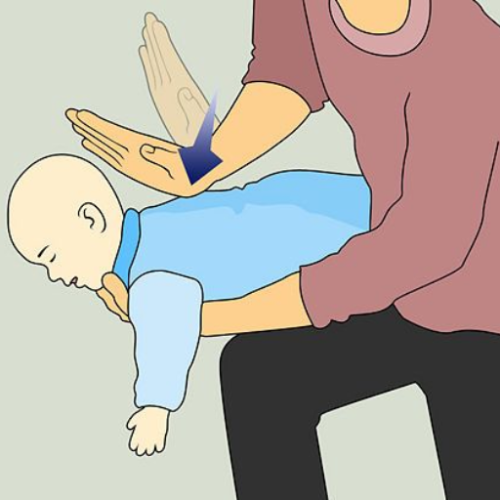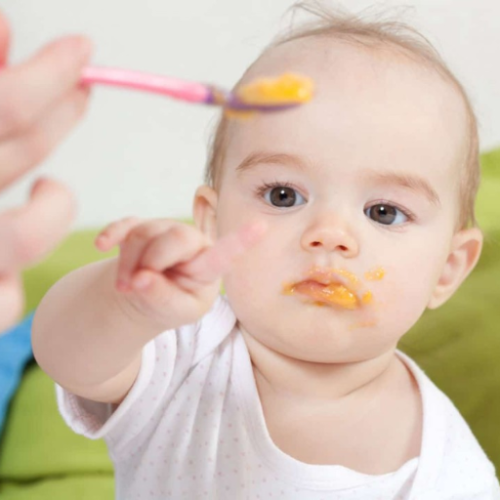![Can Babies Eat Rice? Safe Cooking & Feeding Tips [2024]](https://willnice.net/wp-content/uploads/2024/11/can-babies-eat-rice-1220x670.jpg)
Can Babies Eat Rice?
Yes, babies can eat rice.
You might be concerned about arsenic, a known carcinogen, in rice, especially regarding infant food safety. There's worry that consuming too much arsenic could pose health risks to babies.
However, there is no need to worry. On one hand, it's impossible to completely eliminate arsenic from foods.
On the other hand, in the USA, strict regulations control the amount of inorganic arsenic in rice and rice-based products. These regulations are particularly stringent for products intended for infants and children.
Therefore, when adhering to these guidelines, rice remains a safe food to include in your family's diet.
FDA Guidance on Limiting Arsenic in Infant Rice Cereals
The FDA has issued guidance aimed at reducing infants' exposure to inorganic arsenic, particularly from rice cereals. Recognizing that infants consume about three times more rice relative to their body weight compared to adults—with the highest intake around 8 months of age, a critical period for brain development.
The FDA recommends limiting inorganic arsenic in infant rice cereals to 100 parts per billion (ppb). This guideline is supported by good manufacturing practices, including selective sourcing and rigorous testing of rice and rice-based ingredients, to ensure safety and minimize arsenic levels.
When Can Babies Eat Rice?
You can start offering your baby rice as part of their solid food introduction at around 6 months old. At this age, babies are typically ready to begin eating a variety of solid foods, which can include single-grain cereals like rice cereal.
Understanding Arsenic in Rice
What is Arsenic?
Arsenic is a natural element found widely in the Earth's crust. It exists in both inorganic and organic forms.
Inorganic Arsenic:
- Found in soils, groundwater, and certain minerals.
- Enters the food chain through absorption by plants and animals.
- Highly toxic and classified as a carcinogen when exposed to high levels over time. It is linked to health issues such as skin lesions, cancers, cardiovascular diseases, and developmental problems.
Organic Arsenic:
- Primarily found in marine environments, particularly in seafood like fish and shellfish.
- Combined with carbon, forming less toxic organic compounds.
- Less harmful than inorganic arsenic as it is processed and eliminated more efficiently by the body.
What Is Arsenic in Rice?
Arsenic in rice refers to the presence of arsenic, particularly its more toxic inorganic form, within the rice grains.
Rice absorbs arsenic more easily than other plants because it is often grown in flooded fields that lack oxygen. This environment makes arsenic in the water more soluble and easier for the rice to absorb along with other nutrients. Areas with higher levels of arsenic in the soil or water used for irrigation will result in higher arsenic levels in the rice grown there.
Do All Types of Rice Contain Arsenic?
Yes, all varieties of rice can contain arsenic, but the levels can vary significantly depending on the type of rice, the region where it was grown, and the cultivation practices used. Factors like soil composition, irrigation practices, and the presence of arsenic in local water sources influence arsenic levels in rice.
What Type of Rice is Low in Arsenic?
Basmati and Jasmine rice, particularly those grown in India, Pakistan, and Thailand, tend to have lower arsenic levels compared to other types of rice.
Among U.S.-grown rice, white rice typically has lower arsenic levels than brown rice because arsenic is more concentrated in the bran that is removed during the processing of white rice.
What Type of Rice is High in Arsenic?
Rice types (excluding sushi and quick-cooking rice) sourced from Arkansas, Louisiana, Texas, or broadly labeled as from the U.S. typically contain the highest levels of inorganic arsenic.
Does Organic Rice Have Less Arsenic Than Conventional Rice?
Organic rice is not necessarily lower in arsenic than conventional rice. Arsenic levels are more dependent on environmental factors such as the water and soil where the rice is grown rather than the farming practices (organic vs. conventional).
Organic farming standards focus on avoiding synthetic pesticides and fertilizers but do not control for naturally occurring elements like arsenic in the soil and water used for irrigation.
So the higher-priced organic label doesn’t necessarily equate to lower arsenic levels.
What Type of Rice Is Best for Baby?
The amount of inorganic arsenic in rice can vary based on the type of rice and its geographic origin. White Basmati rice from California, India, and Pakistan, along with sushi rice from the United States, typically contain about half the arsenic of other varieties.
More specifically, White Basmati rice from California has the lowest arsenic content, making it an excellent choice for your baby.
Is Brown Rice More Nutritious Than White Rice?
Yes, brown rice is richer in nutrients than white rice. It provides essential nutrients such as fiber, magnesium, and vitamins B1 and B3, which are crucial for babies and toddlers.
However, brown rice also has higher levels of arsenic. On average, brown rice contains 80% more inorganic arsenic than white rice, as arsenic accumulates in the bran layer that is removed to make white rice.
This doesn't mean you should eliminate brown rice from your baby’s diet, but it shouldn't be the only rice they consume. For a safer option, choose brown basmati rice from California, India, or Pakistan, which typically contains about a third less arsenic than other brown rice.
How to Cook Rice to Reduce Arsenic Levels for Babies?
Cooking rice in a way that reduces arsenic levels is particularly important when preparing it for babies, who are more vulnerable to the toxic effects of arsenic. Here are some steps you can follow to minimize the arsenic content in cooked rice:
Way 1 Optimal Method for Lowering Arsenic in Rice
This method is highly effective for reducing arsenic levels in rice.
Step 1: Thoroughly rinse the rice under cold, running water until the water runs clear. This step helps remove surface arsenic.
Step 2: Boil the water.
Step 3: Start by adding rice to already boiling water, using a 4:1 water-to-rice ratio.
Step 4: Boil for 5 minutes, then drain and discard the water.
Step 5: Add fresh water at a 2:1 water-to-rice ratio.
Step 6: Reduce the heat to medium-low, cover the pot, and continue cooking until the water is fully absorbed by the rice.
We highly recommend it because it can remove over 50% of the arsenic from brown rice and up to 74% from white rice. Research also indicates that this method minimizes nutrient loss during the cooking process.
Way 2 Traditional Asian Rice Cooking Method for Babies
This traditional method is often used in Asia to cook rice for babies.
Step 1 Rinse the Rice
Before cooking, thoroughly rinse the rice under cold, running water until the water runs clear. This can help remove some of the arsenic that's present on the surface.
Step 2 Use Plenty of Water
Cook the rice in a high water-to-rice ratio. Use at least 6 cups of water for every 1 cup of rice. This method allows more arsenic to leach out into the water.
Step 3 Drain the Excess Water
After the rice is cooked, drain off the excess water. This removes some of the arsenic that may have leached out during cooking.
Step 4 Steam the Rice
After draining, you might need to return the rice to the pot, cover it, and let it steam for 10 minutes. This helps to finish the cooking process and improve the texture of the rice.
Notes:
Research has shown that rinsing rice and cooking it in a larger volume of water can remove about 30% of the rice’s inorganic arsenic content. Additionally, diversifying your diet to include nutrients like folate, and vitamins B12, C, and E is suggested to help mitigate the effects of arsenic.
Way 3 Consider Prewashing and Soaking
Soaking rice overnight can further reduce arsenic levels. Drain the soaking water and rinse the rice thoroughly before cooking it in fresh water.
Notes:
If you're short on time and can't follow these steps, don't worry too much. Avoiding arsenic exposure from sources like contaminated well water, fruit juices, and processed rice products like infant rice cereal and puffed rice cakes can significantly reduce dietary arsenic intake.
Is rice cereal a good first food for my baby?
Rice cereal has traditionally been one of the first foods introduced to babies, but it's important to consider a few factors to determine if it's the best choice for your baby:
- Nutritional Value: Rice cereal is fortified with iron, which is crucial for infants, especially after six months when their natural iron reserves start to deplete. However, rice cereal is relatively low in other nutrients.
- Arsenic Concerns: Rice absorbs arsenic from the environment more than other crops, and rice cereal can contain inorganic arsenic. It's advisable that parents also consider other iron-fortified infant cereals like oats, barley, and multigrain as alternatives to provide a variety of nutrients and reduce the risk of arsenic exposure.
- Digestibility: Rice cereal is easy to digest and can be made to a very smooth consistency, which might be gentle on a baby's developing digestive system.
- Allergy Risks: Rice is generally low in allergenic potential, making it a safe option for most babies.
Given these points, rice cereal can be part of a balanced diet but shouldn’t be the sole or primary grain source. It's good to introduce a variety of iron-fortified cereals and other iron-rich foods made from amaranth, quinoa, or oats. Always consult with your pediatrician to decide the best starting solids for your baby, considering their individual health needs and family dietary patterns.
Introducing Rice to Babies with Purees
Baby rice cereal is a common choice for introducing rice in a smooth, pureed form. You can mix cooked white rice with a creamy puree such as hummus or yogurt to create a texture that’s both lumpy and grainy. This combination retains moisture, making it easier for babies to chew.
Serve the mixture on a preloaded spoon to encourage utensil use and promote self-feeding skills. If your baby prefers, allow them to explore the food with their hands, which can be equally effective for developing motor skills.
How to Safely Serve Rice as a Baby-Led Weaning Food?
When serving rice as part of a baby-led weaning approach, it's essential to prioritize both safety and nutritional balance. Here are some comprehensive tips to ensure you serve rice safely to your baby.
- For babies 6 months and older
You can prepare a thick rice congee or porridge. Cook the rice in bone broth, coconut milk, or another nutrient-rich liquid that provides essential fats and proteins. Allow your baby to scoop up the mixture with their hands or offer it on a pre-loaded spoon for easy grabbing.
Alternatively, you can form rice into soft balls or logs, which are easier for babies to pick up and eat using their palmar grasp. Calrose or sushi rice, known for its stickiness, is ideal for creating these easy-to-handle shapes. Simply cook the rice, allow it to cool, and then mold it.
Another baby-friendly option is chopped rice noodles, which can be a manageable way for babies to explore rice as they develop their eating skills.
Top Tip: Enhance the nutritional value by adding nutritional yeast to the rice balls or logs.
- For babies 9 months and older
At 9 months and beyond, you can offer rice rolled into balls that are easy for your child to pick up and bite. Consider trying recipes like arancini, onigiri, or sticky rice, which can be shaped into patties that are simple for little hands to manage.
When serving rice on its own, press the grains slightly with the back of a fork to help them stick together, making it easier for your baby to self-feed. This small adjustment can aid in their ability to grasp and eat the rice independently.
You can also place loose grains on a preloaded spoon, allowing them to practice using their pincer grasp. Be aware that the loose, dry grains might cause gagging as your baby gets used to the texture and learns to chew and swallow the grains effectively.
- For toddlers 18 months and older
Provide rice with age-appropriate utensils such as trainer chopsticks, forks, or spoons. It's normal for toddlers to still use their hands, so don't be surprised if they do.
Since rice can be challenging for little ones to pick up with utensils, consider preparing it to be stickier and moister. This texture adjustment makes it easier for your child to successfully use utensils while eating.
Note:
Every baby develops differently, and our food preparation suggestions are broad guidelines, informed by the latest scientific research on oral motor development to minimize choking risks. However, these recommendations are for informational purposes only and should not replace advice from your pediatrician or healthcare provider.
Is Rice a Choking Hazard for Babies?
Rice is not typically considered a major choking hazard for babies primarily due to its small size and the way it softens significantly when cooked. Here are the key reasons why rice generally poses a low risk of choking:
- Soft Texture: Properly cooked rice has a very soft texture that easily conforms to the shape of a baby's mouth and throat, reducing the risk of blocking the airway.
- Size: The individual grains of rice are small. When cooked, they tend to stick together and can be mashed or clumped into even safer, manageable sizes for babies just starting on solids.
- Ease of Swallowing: Soft, cooked rice can be swallowed with minimal need for chewing, which is ideal for babies who have not yet developed full chewing abilities.
- Adaptable Preparation: Rice can be prepared in various ways that are safe for babies, such as mixing with breast milk, formula, or water to create a smooth rice porridge, which minimizes any potential choking risk even further.
Note:
Rice products like mochi and steamed rice cakes can indeed be a significant choking hazard, particularly in regions like Japan. The chewy, dense, and sticky consistency of these rice products makes them difficult to swallow, especially for babies, children, and elderly people who may have trouble chewing or swallowing properly.
These characteristics can cause the mochi or rice cake to become lodged in the throat, leading to choking incidents.
It's important to approach feeding rice to babies with some considerations to ensure safety:
- Consistency: Ensure that the rice is cooked until it is very soft. Hard, undercooked grains could pose a risk for younger babies who are still learning to chew.
- Stickness: When babies are first starting on solids, including rice, it's often easier and safer to serve it in a form that sticks together, such as rice balls or mixed with a thicker puree that helps the rice clump together. This can be easier for them to manage and less likely to cause choking.
- Supervision: Always supervise your baby while they are eating. Even foods that aren't typical choking hazards can become risks if a baby eats too quickly, doesn't chew thoroughly, or is eating while distracted or moving around.
- Gradual Introduction: Start with small quantities and watch how your baby handles eating rice. If they struggle with the texture or size, you may need to modify how you prepare it.
- Preparation Tips: For very young babies or those just starting solids, consider grinding rice into a fine powder and cooking it into a smooth porridge. This can be a safer way to introduce rice as it minimizes any risk of choking.
Ultimately, rice can be a safe part of your baby's diet if prepared appropriately and introduced in a way that suits their eating skills and development stage. Always follow guidelines on starting solids and consult with your pediatrician if you have concerns about choking risks or feeding practices.








 Login with Google
Login with Google Login with Facebook
Login with Facebook